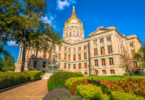The city of Providence is the capital of the state of Rhode Island. It is also one of the United States’ oldest cities, having been founded in 1636 by Roger Williams. Williams was a Reformed Baptist theologian who had been exiled from the Massachusetts Bay Colony for his religious beliefs. Williams named his new city Providence in honor of the merciful providence of God that he believed was the reason that he and those who followed him were able to find such a secure religious haven for themselves in the New World. The city is located at the mouth of the Providence River, which is at the top of Narragansett Bay.
The city is one of the first in the nation to become an industrial one. It was noted for its textile manufacturing early on, and later became a hub for jewelry making, machine tool manufacturing, and silverware manufacturing. In today’s modern times, there are eight hospitals in Providence, which is a lot for anyone city, as well as seven colleges and universities. These things have changed Providence’s primary industry from manufacturing to health care and higher education. There is still manufacturing going on in Providence, but it is not the primary industry there anymore.
The city of Providence is the third most populous city in the New England area, behind only Boston and Worcester. The little colony of Providence eventually merged with other small colonies in the area to become the larger colony of Rhode Island and Providence Plantations (usually known by its shorter name of Rhode Island). It was a popular destination for religious dissenters from the Massachusetts Bay Colony in its early decades, as Williams had a policy of welcoming anyone there, regardless of their religious views–something that did not endear him to the Puritan authorities in Massachusetts. In fact, they viewed him and his colony as a thorn in their sides, and often referred to it as the derisive phrase “Rogue Island,” instead of “Rhode Island,” because of what they saw as the heretics it harbored.

The city of Providence was burned down by Narragansett Native Americans in March of 1676 during King Philip’s War. This was done even though Williams had established excellent relations between his colony and the Native religious leaders who were waging war with the New England colonies. Williams held no hard feelings toward the Narragansetts for this, however. Instead, the Rhode Island colonial legislature, under Williams’s direction, issued a proclamation formally rebuking the other New England colonies for pushing the Narragansetts to war with them.
When the Revolutionary War came along, the citizens of Providence were among the first casualties of it. In fact, the got a head start in the Gaspee Affair of 1772. The colony of Rhode Island, with Providence leading the way, was the first of the thirteen colonies to renounce its allegiance to the British crown. On the other hand, it was the last of the original thirteen states to ratify the newly proposed US Constitution and only did so after they were given assurances that a Bill of Rights would be added to it.
After the Revolution, Providence became the ninth most populous city in the new nation. Its economy, which was originally based on shipbuilding, fishing, and other maritime ventures, moved to manufacturing. Its importance in manufacturing grew over the next two centuries until it was hosting some of the largest manufacturing plants in the country by the early twentieth century. A few of the big-name manufacturing plants that were located in Providence at that time included Gorham Manufacturing Company, Nicholson File, and Brown & Sharpe.
The citizens of Providence ratified a charter in 1831 that made them an official incorporated city. This was just after the city’s population went past 17,000 people. The citizens decided the city government should be headquartered in the Market House, which was located in Market Square. It stayed there from 1832 to 1878 and was not only the geographical center of the city but also its social center. As the city’s population grew, the city government outgrew its original building, and the City Council made a resolution in 1845 to build a new municipal building. This building was completed and named Providence City Hall in 1878.
At the time of the Civil War, the city of Providence was divided over the issue of slavery. Many citizens there supported abolition, but others had businesses that had crucial ties to the Southern cotton industry (particularly those in the textile business in Providence), and that industry depended largely on slaves at that time. Even though there was this divide in Providence, and an ambivalence about the war in general in that city, their military volunteers regularly exceeded their federally demanded quota. The manufacturing industry in Providence also proved to be of crucial importance to the Union. After the war, Providence thrived as a city in every way, and immigrants from other states and other countries brought the population of the city higher and higher.
By the early twentieth century, the city of Providence was one of the wealthiest ones in the country. This wealth was powered largely by immigrants who worked in the large, important manufacturing plants there. A wide variety of products were made in Providence at that time, including tools, steam engines, silverware, textiles, screws, and other interesting things.
Like most other major cities in the United States, Providence went through a bit of urban decline in the 1970s and 1980s. To improve the city, $606 million dollars of local and national funds were invested into the city of Providence. A larger push for revitalization of the downtown area came in the 1990s, which resulted in the realignment of the north-south railroad tracks, taking out the large railway viaducts that divided downtown from the capitol building, creating Waterplace Park by uncovering and moving rivers that had been hidden by paved bridges, building the Fleet Skating Rink–which is today known as the Alex and Ani City Center, and building the Providence Place Mall.






